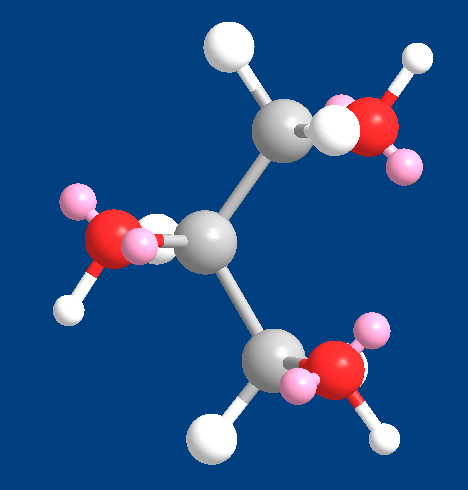Glycerol
Overview
Glycerol is a chemical compound also commonly called glycerin or glycerine. It is a colorless, odorless, viscous liquid that is widely used in pharmaceutical formulations. Glycerol is a sugar alcohol, and is sweet-tasting and of low toxicity. Glycerol has three hydrophilic alcoholic hydroxyl groups that are responsible for its solubility in water and its hygroscopic nature. Its surface tension is 64.00 mN/m at 20 °C , and it has a temperature coefficient of -0.0598 mN/(m K). The glycerol substructure is a central component of many lipids.
Synthesis and production

Until recently, synthetic glycerol was mainly manufactured at an industrial scale from epichlorohydrin. Since glycerol forms the backbone of triglycerides, it is produced on saponification or transesterification. Soap-making and biodiesel production are respective examples.
Glycerol is a 10% by-product of biodiesel production (via the transesterification of vegetable oils). This has led to a glut of crude glycerol in the market, making the epichlorohydrin process no longer economical. Current levels of glycerol production are running at about 350,000 tons per annum in the USA, and 600,000 tpa in Europe. This will increase as it implements EU directive 2003/30/EC which requires replacement of 5.75% of petroleum fuels with biofuel, across all Member States by 2010[1].
Applications
In foods and beverages, glycerol serves as humectant, solvent and sweetener, and may help preserve foods. It is also used as filler in commercially prepared low-fat foods (e.g., cookies), and as a thickening agent in liqueurs. Glycerol also serves as a way, along with water, to preserve certain types of leaves. Glycerol is also used as a sugar substitute. In this regard, it has approximately 27 calories per teaspoon and is 60% as sweet as sucrose. Although it has about the same food energy as table sugar, it does not raise blood sugar levels, nor does it feed the bacteria that form plaques and cause dental cavities. As a food additive, glycerol is also known as E number E422.
In organic synthesis, glycerol is used as a readily available prochiral building block.
Feedstock
It is one of the major raw materials for the manufacture of polyols for flexible foams, and to a lesser extent rigid polyurethane foams.
Glycerol is used to produce nitroglycerin, which is an essential ingredient of smokeless gunpowder and various munitions. Reliance on soap-making to supply co-product glycerine made it difficult to increase production to meet wartime demand. Hence, synthetic glycerin processes were national defense priorities in the days leading up to World War II.
Glycerol is also used to manufacture mono- and di-glycerides for use as emulsifiers, as well as polyglycerol esters going into shortenings and margarine.
Research laboratory usage
Glycerol is a common component of solvents for enzymatic reagents stored at temperatures below zero degrees Celsius due to the depression of the freezing temperature of solutions with high concentrations of glycerol. It is also dissolved in water to reduce damage by ice crystals to laboratory organisms that are stored in frozen solutions, such as bacteria, nematodes, and fruit flies. Samples are loaded into agarose gel electrophoresis mixed in loading buffers that mainly consist of glycerol; when the sample is injected into wells, the glycerol causes the solution to sink through the running buffer to the bottom of the well.
Pharmaceutical and personal care applications
Glycerol is used in medical and pharmaceutical and personal care preparations, mainly as a means of improving smoothness, providing lubrication and as a humectant. It is found in cough syrups, elixirs and expectorants, toothpaste, mouthwashes, skin care products, shaving cream, hair care products, and soaps.
As a 10% solution, glycerol prevents tannins from precipitating in ethanol extracts of plants (tinctures). It is also used as a substitute for ethanol as a solvent in preparing herbal extractions. It is less extractive and is approximately 30% less able to be absorbed by the body. Fluid extract manufacturers often extract herbs in hot water before adding glycerin to make glycerites.[2][3][4]
Used as a laxative when introduced into the rectum in suppository or liquid (enema) form; irritates the bowel and induces a hyperosmotic effect.
Glycerol is a component of glycerol soap, which is made from denatured alcohol, glycerol, sodium castorate (from castor]]), sodium cocoate, sodium tallowate, sucrose, water, and parfum (fragrance). Sometimes one adds sodium laureth sulfate. This kind of soap is used by people with sensitive, easily-irritated skin because it prevents skin dryness with its moisturizing properties. It is possible to make glycerol soap at home.
It is also used in de-/anti-icing fluids, as in vitrification of blood cells for storage in liquid nitrogen
Potential uses
A great deal of research is being conducted to try to make value-added molecules from crude glycerol (typically containing 20 % water and residual esterification catalyst) obtained from biodiesel production, as an alternative to disposal by incineration. One such program to add value to this glut of glycerol is the UK-based initiative The Glycerol Challenge. Some potential uses for glycerol include the following:
- Hydrogen gas production unit
- Glycerine acetate (as a potential fuel additive)[5]
- Compost additive
- Citric acid production
- Cosmetic bonding agent for makeup, including: eye shadow, lipstick, lipgloss, and lotions and also including eyedrops as well
- Conversion to propylene glycol[6].
- Conversion to acrolein[7][8]
- Conversion to ethanol[9]
- Conversion to epichlorhydrin[10], a raw material for epoxy resins.
Metabolism
Glycerol is a precursor for synthesis of triacylglycerols and of phospholipids in the liver and adipose tissue. When the body uses stored fat as a source of energy, glycerol and fatty acids are released into the bloodstream. The glycerol component can be converted to glucose by the liver and provides energy for cellular metabolism.
Before glycerol can enter the pathway of glycolysis or gluconeogenesis (depending on physiological conditions), it must be converted to their intermediate glyceraldehyde 3-phosphate in the following steps:
| Glycerol | Glycerol kinase | Glycerol-3-phosphate | Glycerol-3-phosphate dehydrogenase | Dihydroxyacetone phosphate | Triosephosphate isomerase | Glyceraldehyde 3-phosphate | |||
| ATP | ADP | NAD+ | NADH |

| |||||

|

|

| |||||||
| NAD+ | NADH |
||||||||
The enzyme glycerol kinase is present only in the liver. In adipose tissue, glycerol 3-phosphate is obtained from dihydroxyacetone phosphate (DHAP) with the enzyme glycerol-3-phosphate dehydrogenase.
Danger of contamination with diethylene glycol
On May 4, 2007, the US Food and Drug Administration advised all US makers of medicines to test all batches of glycerine for the toxic diethylene glycol.[11] This follows an occurrence of 100 fatal poisonings in Panama resulting from a Chinese factory deliberately falsifying records in order to export the cheaper diethylene glycol as the more expensive glycerol.[12] Glycerine and diethylene glycol are similar in appearance, smell, and taste. The US Federal Food, Drug, and Cosmetic Act was passed following the 1937 "Elixir Sulfanilamide" incident of poisoning caused by diethylene glycol contamination of medicine.
See also
References
- ↑ The Glycerol Challenge
- ↑ Walter S. Long. The Composition of Commercial Fruit Extracts Transactions of the Kansas Academy of Science (1903-), Vol. 28, Jan. 14, 1916 - Jan. 13, 1917 (Jan. 14, 1916 - Jan. 13, 1917), pp. 157-161 doi:10.2307/3624347
- ↑ David Winston www.herbaltherapeutics.com
- ↑ Does Alcohol Belong In Herbal Tinctures?
- ↑ J. A. Melero, R. vanGrieken, G. Morales and M. Paniagua (2007). "Acidic Mesoporous Silica for the Acetylation of Glycerol: Synthesis of Bioadditives to Petrol Fuel". Energy Fuels. 21 (3): 1782–1791. doi:10.1021/ef060647q.
- ↑ "Dow Achieves Another Major Milestone in its Quest for Sustainable Chemistries" (Press release). Dow Chemical Company. 15 Mar 2007.
- ↑ L. Ott, M. Bicker and H. Vogel (2006). "The catalytic dehydration of glycerol in sub- and supercritical water: a new chemical process for acrolein production". Green Chemistry. 8 (2): 214–220. doi:10.1039/b506285c. Text " Green Chemistry " ignored (help)
- ↑ Watanabe, M.; et al. (2007). "Acrolein synthesis from glycerol in hot-compressed water". Bioresource Technology. 98: 1285–1290.
- ↑ S. S. Yazdani and R. Gonzalez (2007). "Anaerobic fermentation of glycerol: a path to economic viability for the biofuels industry". Current Opinion in Biotechnology. 18 (3): 213–219. doi:10.1016/j.copbio.2007.05.002. Lay summary – ScienceDaily (27 Jun 2007).
- ↑ "Dow Epoxy Advances Glycerine-To-Epichlorohydrin and Liquid Epoxy Resins Projects by Choosing Shanghai Site" (Press release). Dow Chemical Company. 26 March 2007.
- ↑ U.S. Food and Drug Administration. "FDA Advises Manufacturers to Test Glycerin for Possible Contamination." Released May 4, 2007. Last retrieved May 8, 2007.
- ↑ WALT BOGDANICH and JAKE HOOKER. "From China to Panama, a Trail of Poisoned Medicine." New York Times. Published: May 6, 2007. Last retrieved May 8, 2007.
External links
- Glycerol on BioChemInfo.org
- Absolute alcohol using glycerol
- Computational Chemistry Wiki
- Physical Propetry of glycerol
ar:جليسرول
bg:Глицерин
ca:Glicerol
cs:Glycerol
da:Glycerin
de:Glycerin
et:Glütserool
eo:Glicerino
gl:Glicerol
ko:글리세롤
hr:Glicerol
is:Glýseról
it:Glicerolo
he:גליצרול
lv:Glicerīns
lb:Glycerol
lt:Glicerolis
hu:Glicerin
nl:Glycerine
no:Glyserol
nn:Glyserol
sl:Glicerol
fi:Glyseroli
sv:Propantriol
uk:Гліцерин